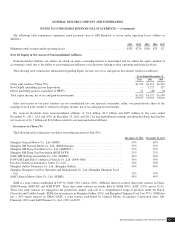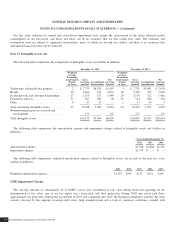General Motors 2012 Annual Report Download - page 109
Download and view the complete annual report
Please find page 109 of the 2012 General Motors annual report below. You can navigate through the pages in the report by either clicking on the pages listed below, or by using the keyword search tool below to find specific information within the annual report.
GENERAL MOTORS COMPANY AND SUBSIDIARIES
NOTES TO CONSOLIDATED FINANCIAL STATEMENTS — (Continued)
To determine the estimated fair value of real and personal property, the cost approach, market approach and income approach were
considered. Under the cost approach, the determination of fair value considered the estimates of the cost to construct or purchase a
new asset of equal utility at current prices with adjustments in value for physical deterioration, functional obsolescence, and economic
obsolescence. Under the market approach, the determination of fair value considered the market prices in transactions for similar
assets and certain direct market values based on quoted prices from brokers and secondary market participants for similar assets.
Under the income approach, the determination of fair value considered the estimate of the present worth of future benefits derived
from ownership, usually measured through the capitalization of a specific level of income which can be derived from the subject asset
with adjustments in value for demolition costs and for the effect of an estimated holding period. Under the income approach, it was
assumed fair value could not exceed the present value of the net cash flows discounted at a rate commensurate with the level of risk
inherent in the subject asset. An in-exchange premise was determined to be the highest and best use.
The following table summarizes the significant Level 3 inputs for real and personal property measurements:
Valuation Technique(s) Unobservable Input(s) Range
Real Property ........................................ Market approach Demolition costs (a) 6% - 23%
Cost approach Holding period (b) 0 - 4 years
Income approach Discount rate (c) 11.2% - 14.5%
Personal Property ..................................... Market approach Physical deterioration (d) 52% - 69%
Cost approach Functional obsolescence (e) 8% - 28%
Economic obsolescence (f) 17% - 23%
(a) Represents estimated gross cost to demolish and clear the structures on the property as a percentage of replacement cost new.
(b) Represents estimated marketing period for each property; which dictates the amount of property specific holding costs to be
incurred such as real estate taxes.
(c) Represents the discount rate for the specific property based on local market sources and available benchmarking data.
(d) Represents estimates of loss in asset value due to wear and tear, action of the elements, and other physical factors that reduce the
life and serviceability of the asset.
(e) Represents estimated loss in asset value caused by inefficiencies and inadequacies of the asset itself.
(f) Represents estimated loss in asset value caused by factors external to the asset such as legislative enactments, changes in use,
social change, and change in supply and demand.
As a result of our fair value estimates, we adjusted the carrying amount of the GME real and personal property to fair value and
recorded asset impairment charges of $3.7 billion at December 31, 2012. These charges were recorded in our GME segment with $3.5
billion recorded in Automotive cost of sales and $0.2 billion recorded in Automotive selling, general and administrative expense. The
fair value estimates for GME real and personal property are based on a valuation premise that assumes the assets’ highest and best use
are different than their current use due to the overall European macro-economic environment.
The following table summarizes GME real and personal property measured at fair value utilizing Level 3 inputs on a nonrecurring
basis (dollars in millions):
Fair Value Measure Level 1 Level 2 Level 3 Total Impairment
Year ended December 31, 2012 ............................... $408 $— $— $408 $3,714
Our recoverability test of the GME asset group also included intangible assets and other long-lived assets resulting in additional
impairment charges of $1.8 billion at December 31, 2012, for a total of $5.5 billion. Refer to Note 13 for additional information
regarding the impairment of intangible assets.
General Motors Company 2012 ANNUAL REPORT106
























